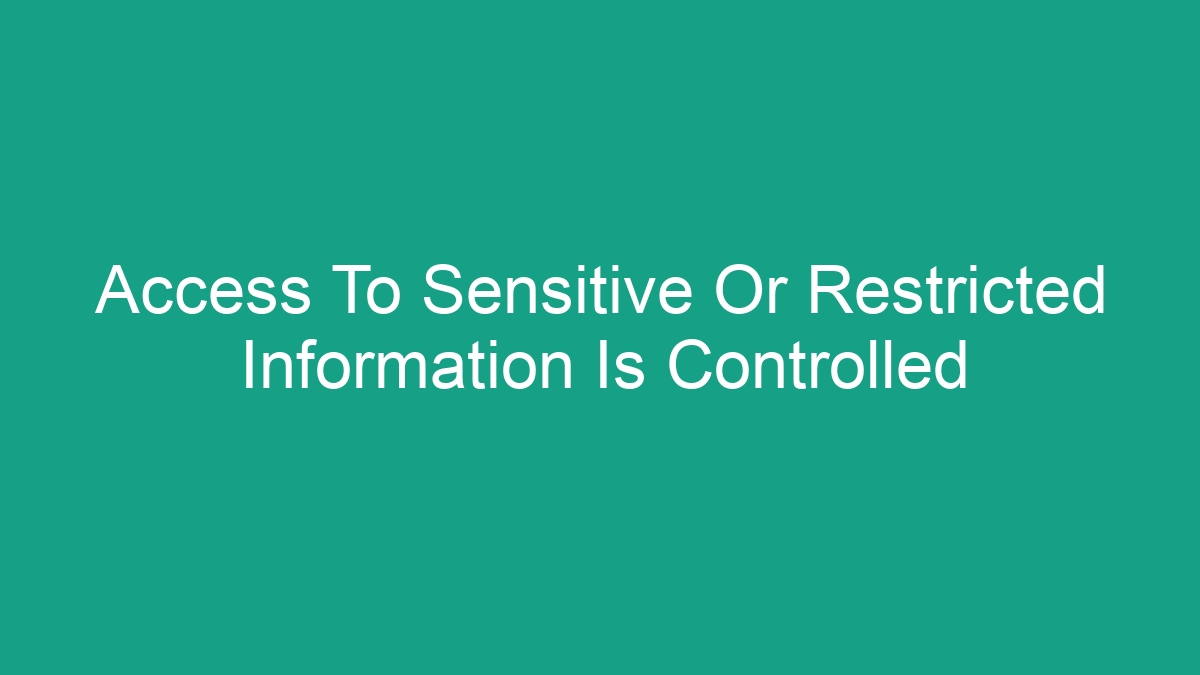
Access to sensitive or restricted information is a critical aspect of ensuring the security and confidentiality of data within organizations. Effective control measures need to be in place to prevent unauthorized access, misuse, or exposure of sensitive information. This article will delve into the importance of controlling access to sensitive information and the various measures that can be adopted to secure such data.
The Importance of Controlling Access to Sensitive Information
1. Protection of Confidential Data: Sensitive information such as personal data, financial records, and proprietary business information needs to be safeguarded from unauthorized access. Controlling access ensures that only authorized individuals can view or manipulate the data, reducing the risk of data breaches and leaks.
2. Compliance with Regulations: Many industries, such as healthcare and finance, are subject to strict regulations governing the protection of sensitive information. Controlling access is crucial for ensuring compliance with data protection laws and industry regulations.
3. Mitigation of Insider Threats: Insiders with legitimate access to sensitive information can pose a significant threat to the security of the data. Controlling access helps in monitoring and tracking user activities to identify any anomalies or unauthorized actions.
Measures for Controlling Access to Sensitive Information
1. Role-Based Access Control (RBAC): RBAC is a method of restricting system access based on the roles of individual users within an organization. It assigns permissions to roles rather than individual users, making it easier to manage access rights.
2. User Authentication: Implementing strong authentication methods such as multi-factor authentication (MFA) adds an extra layer of security to access control. This ensures that only authorized users with valid credentials can access sensitive information.
3. Encryption: Encrypting sensitive data at rest and in transit ensures that even if unauthorized access occurs, the data remains unreadable and unusable. This provides an added layer of protection against data breaches.
4. Access Logging and Monitoring: Logging and monitoring user access to sensitive information helps in identifying suspicious activities and enforcing accountability. It allows organizations to track who accessed what data and when.
5. Data Loss Prevention (DLP): DLP solutions help in preventing the unauthorized transfer of sensitive information outside the organization’s network. They can monitor and control the movement of data to prevent data leaks.
6. Regular Access Reviews: Conducting periodic reviews of user access rights ensures that only necessary and appropriate access is granted. This helps in identifying and revoking unnecessary access privileges.
Challenges in Access Control
1. Balancing Security and Accessibility: Organizations often struggle to find the right balance between ensuring stringent access control and enabling employees to perform their tasks efficiently. Overly restrictive access controls can hinder productivity, while lax controls can lead to security vulnerabilities.
2. Complexity of Managing Access Rights: As organizations grow in size and complexity, managing access rights for numerous users across multiple systems and applications becomes a daunting task. This can lead to inconsistency and gaps in access control.
3. User Education and Awareness: Employees need to be educated about the importance of access control and the best practices for safeguarding sensitive information. Lack of awareness can lead to inadvertent security breaches.
Best Practices for Effective Access Control
1. Implement a Least Privilege Principle: Only grant users the minimum level of access required to perform their job functions. This reduces the risk of unauthorized access to sensitive information.
2. Regularly Update Access Policies: As the organization evolves, access policies should be reviewed and updated to align with current security requirements and business needs.
3. Leverage Automation: Use automated tools and solutions to streamline access management processes, ensuring consistency and efficiency in access control.
4. Conduct Security Awareness Training: Train employees on the importance of access control, the risks associated with unauthorized access, and the procedures for handling sensitive information securely.
Conclusion
Controlling access to sensitive or restricted information is a critical aspect of information security. It is essential for protecting confidential data, ensuring compliance with regulations, and mitigating insider threats. By implementing measures such as role-based access control, user authentication, encryption, and access logging, organizations can effectively control access to sensitive information and safeguard their data from unauthorized access. Despite the challenges, adopting best practices and raising employee awareness can significantly enhance the effectiveness of access control measures.


